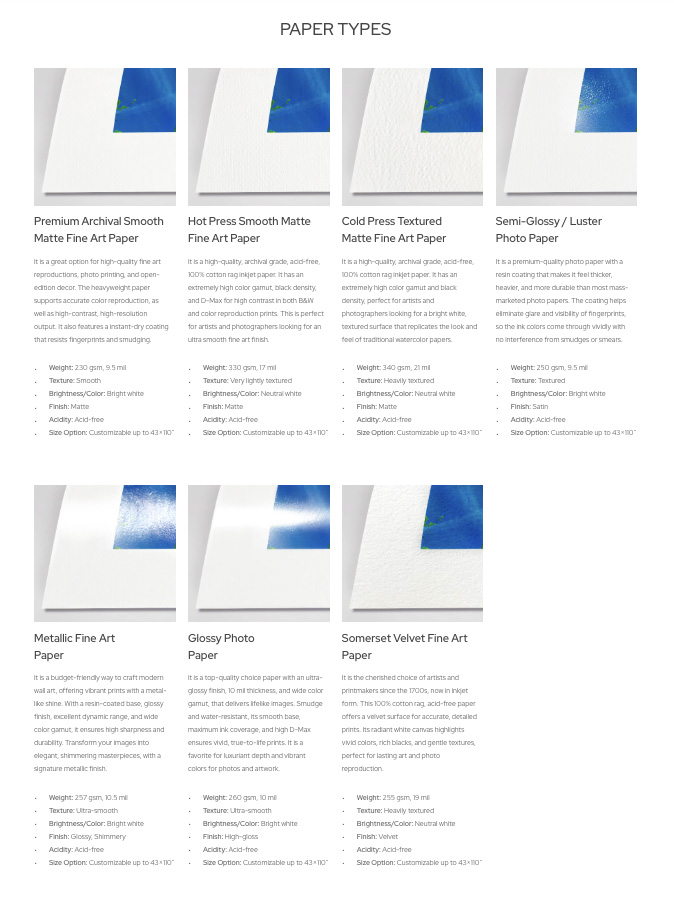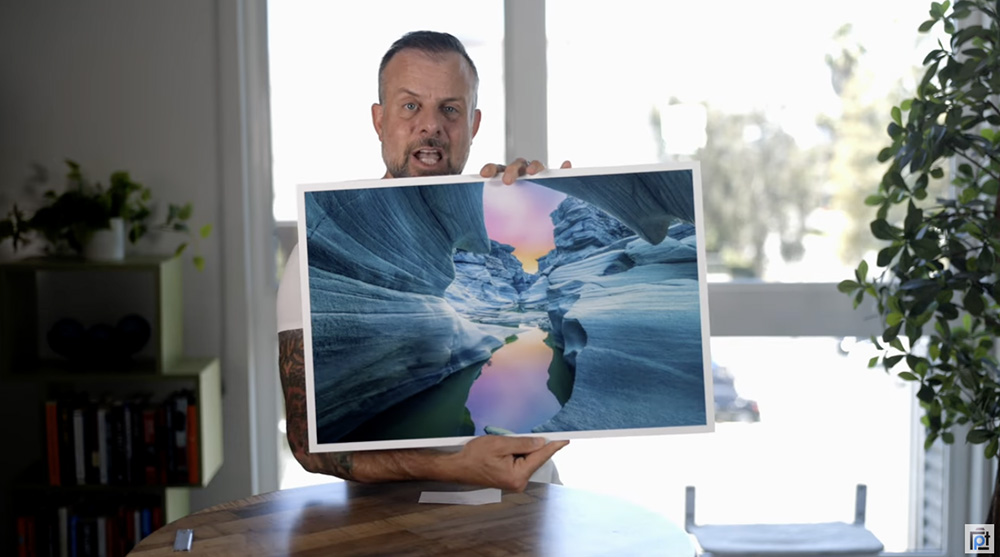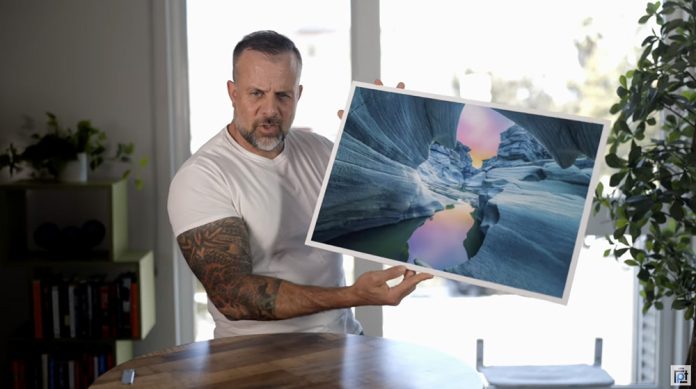There’s something extraordinary about holding a printed photograph in your hands. It has weight, texture, and permanence that simply can’t be matched by an image on a screen. Whether you’re a professional photographer selling your work or an enthusiast printing images for your home, the paper you choose makes all the difference in how your images are experienced. Take it from me—I’ve worked in photography for decades, and there is no better feeling than seeing one of your best images as a gorgeous print.
Fine art paper has become the benchmark for photographers who want to elevate their work from “just a print” to a piece of art. This archival-grade medium not only enhances the color, texture, and depth of your photographs but also ensures they can be preserved for generations. It’s about creating more than a picture—it’s about creating an heirloom.
In this guide, we’ll explore what fine art paper is, why it matters, the types available, and how companies like Lumaprints are helping photographers produce gallery-quality work. If you’ve ever wondered which paper would best suit your photography style, or how to ensure your prints last as long as your passion, read on.
Table of Contents
- What Is Fine Art Paper?
- Why Print on Fine Art Paper?
- Types of Fine Art Paper
- Choosing the Right Fine Art Paper for Your Photography
- Color Accuracy and Print Longevity
- Beyond the Paper: Display Options for Fine Art Prints
- Cost and Accessibility of Fine Art Paper Prints
- Transform Your Photos
- FAQ
What Is Fine Art Paper?

Fine art paper is not your typical consumer-grade photo paper. It’s designed to meet the archival standards required by galleries, collectors, and museums. This means the paper is acid-free, lignin-free, and engineered to resist yellowing or degrading over time. When paired with giclée printing—a high-resolution inkjet process that uses pigment-based inks—the result is a print that combines incredible detail with exceptional longevity.
Unlike mass-market glossy photo papers, fine art paper offers a range of textures and finishes. These subtle differences have a profound effect on how an image feels when viewed. For instance, a smooth matte surface can give a photograph a calm, understated mood, while a textured paper can add depth and tactile richness.
Another hallmark of fine art paper is its weight and thickness. With grams per square meter (gsm) often ranging from 230 to 340 and beyond, it feels substantial in the hand. This heft adds to the perception of value, making prints suitable for sale, exhibition, or personal enjoyment as heirlooms.
Ultimately, fine art paper is about respect—for the image, for the craft, and for the story the photographer is telling. It ensures that the vision captured in the camera is carried through to the final print with accuracy and elegance.
Why Print on Fine Art Paper?

Printing on fine art paper transforms the viewing experience. Colors appear richer and more nuanced, blacks are deeper, and details stand out in ways that digital screens can’t replicate. For photographers who spend hours perfecting their edits, this is the medium that does justice to that effort.
Longevity is another compelling reason. Fine art paper, combined with pigment-based inks, can resist fading for more than 100 years. This means your photographs won’t just live in the present—they’ll be passed down, retaining their brilliance for generations to come.
Presentation also plays a critical role. A print on fine art paper immediately looks more professional, whether framed, mounted, or displayed in a portfolio. This isn’t just about aesthetics; for photographers selling prints, the quality of the paper can directly impact a buyer’s perception of value.
Finally, there’s the tactile and emotional aspect. Holding a piece of fine art paper print in your hands connects you physically to the work. It’s a reminder that photography is more than pixels—it’s art, and it deserves to be treated as such.
Types of Fine Art Paper

I’ve worked with Lumaprints for some time now, and have ordered prints on all sorts of substrates from them. Lumaprints has a range of fine art papers, each with unique characteristics. Understanding these options helps you match your photography style with the paper that enhances it best.
Premium Archival Smooth Matte Fine Art Paper
This smooth matte paper is ideal for photographers who want clean detail and subtle tones. Its bright white base ensures accurate color reproduction and strong contrast, while the instant-dry coating makes it resistant to smudges. It’s a versatile option, perfect for both color and black-and-white photography.
Hot Press Smooth Matte Fine Art Paper
Made from 100% cotton rag, this fine art paper has a luxurious feel and exceptional color gamut. The smooth surface brings out incredible detail, making it an excellent choice for high-contrast images. For portraits and fine detail work, this is often the go-to paper.
Cold Press Textured Matte Fine Art Paper
With its heavily textured surface, cold press fine art paper resembles traditional watercolor paper. It’s perfect for artists and photographers who want to add depth and tactile character to their prints. Black-and-white landscapes and pastel color palettes benefit greatly from this surface.
Semi-Gloss / Luster Photo Paper
This semi-gloss fine art paper balances vibrancy with durability. It reduces glare and resists fingerprints, making it easier to handle and display. Colors pop with impressive clarity, making it a practical choice for prints that need to be both beautiful and durable.
Metallic Fine Art Paper
For photographers who want their images to shimmer, metallic fine art paper adds a unique reflective quality. It’s particularly effective for high-contrast images, cityscapes, or abstracts where shine enhances the mood. The result is modern, eye-catching wall art.
Glossy Photo Paper
Glossy fine art paper delivers lifelike vibrancy, with a smooth surface that maximizes depth and saturation. It’s water and smudge-resistant, making it a practical choice for photographers seeking to highlight bold colors and striking details.
Somerset Velvet Fine Art Paper
A classic choice dating back centuries, Somerset Velvet is 100% cotton rag with a soft, velvet-like texture. This fine art paper is perfect for archival-quality art reproductions, delivering deep blacks, radiant whites, and a luxurious tactile quality.
Choosing the Right Fine Art Paper for Your Photography

Choosing fine art paper is as much about your creative intent as it is about technical specifications. A matte paper might better convey subtlety in a portrait, while a glossy or metallic finish can make bold colors sing in a fashion or landscape shot.
Surface texture also plays a key role. Smooth papers highlight detail and precision, while textured papers add depth and evoke traditional art mediums like watercolor or etching. Consider the story you want the print to tell and select a surface that supports that narrative.
Finishes matter too. Glossy surfaces enhance contrast and saturation, while matte surfaces reduce glare and emphasize mood. For large prints or those displayed under strong lighting, matte papers are often easier on the eyes and more practical for display.
Ultimately, there’s no one-size-fits-all answer. Many photographers experiment with multiple types of fine art paper until they discover the combination that resonates most with their artistic voice. That exploration is part of the creative process.
Color Accuracy and Print Longevity
One of the hallmarks of fine art paper printing is precision in color reproduction. Lumaprints uses Canon giclée printers calibrated regularly to ensure colors match the photographer’s vision. Pigment-based inks penetrate the surface of fine art paper in a way that maintains vibrancy and depth without oversaturation.
This combination ensures prints are not only beautiful today but will remain so for decades. Independent testing shows that pigment prints on fine art paper can last over a century without noticeable fading when displayed properly.
For professionals, this longevity builds trust with clients and collectors. When you sell a print on fine art paper, you’re offering more than a photo—you’re offering a guarantee of enduring quality.
Beyond the Paper: Display Options for Fine Art Prints
Once your work is printed on fine art paper, presentation becomes the next step. Framing is the traditional choice, providing protection and enhancing the visual impact. A well-chosen frame and mat elevate the piece and help it integrate seamlessly into a collector’s space.
Foam-mounted prints offer a lightweight, modern alternative. They allow for a clean, gallery-like presentation without the bulk of traditional framing. For exhibitions or contemporary spaces, this option can be especially appealing. Plus, as I discuss in my video above, they’re extremely budget-friendly!
Lumaprints provides both options, giving photographers flexibility in how they want to present their work. The choice often comes down to where the print will be displayed and the mood the photographer wants to create.
Cost and Accessibility of Fine Art Paper Prints
There’s a common misconception that printing on fine art paper is prohibitively expensive. While it’s true that the materials and processes are premium, the actual costs can be surprisingly accessible. At Lumaprints, for instance, an 8×10 archival print starts at just a few dollars, while larger gallery-size prints remain within reach for professionals and enthusiasts alike.
For photographers selling their work, the added value that fine art paper brings often justifies a higher price point. Buyers recognize the difference in quality and are willing to invest in prints that feel substantial and enduring.
In the end, fine art paper isn’t just about cost—it’s about value. The durability, appearance, and prestige it adds to your work make it a wise investment.
Transform Your Photos

Fine art paper transforms photography from a fleeting image into something tangible, lasting, and worthy of admiration. It’s about more than printing—it’s about respecting your craft, honoring your vision, and creating art that stands the test of time.
With options ranging from smooth matte to textured velvet and shimmering metallics, there’s a fine art paper suited to every style of photography. Exploring these options allows you to find the perfect match for your work.
For photographers serious about quality, Lumaprints offers the expertise, materials, and craftsmanship to bring your images to life. Your art deserves nothing less.
FAQ
What is fine art paper?
Fine art paper is archival-grade, acid-free paper designed for long-lasting, high-quality prints. It enhances color accuracy, texture, and detail, making photographs suitable for gallery display and long-term preservation.
Why should I choose fine art paper over standard photo paper?
Fine art paper offers better longevity, richer colors, and more professional presentation compared to standard consumer photo paper. It ensures your prints resist fading and maintain their beauty for generations.
Which type of fine art paper is best for black-and-white photography?
Matte papers such as hot press or cold press are excellent choices for black-and-white photography. They offer strong contrast, deep blacks, and a refined look without glare.
Does fine art paper really last over 100 years?
Yes. When combined with pigment-based inks and proper care, prints on fine art paper can last more than a century without noticeable fading, making them ideal for archival and collectible purposes.
Is printing on fine art paper expensive?
Not necessarily. While it is more premium than mass-market paper, fine art prints are available at accessible prices, especially through services like Lumaprints. The added value often outweighs the modest increase in cost.
How do I decide between textured and smooth fine art paper?
Smooth papers highlight detail and precision, making them great for portraits and sharp images. Textured papers add depth and character, ideal for landscapes or art-inspired photographs.
Can I get fine art paper prints framed or mounted?
Yes. Lumaprints offers both framed and foam-mounted options, allowing you to choose a presentation style that best suits your work and display needs.
Friendly disclaimer: Our articles may contain affiliate links that support us without costing you more, and sometimes we spice things up with sponsored content—but only for products we truly stand behind!

